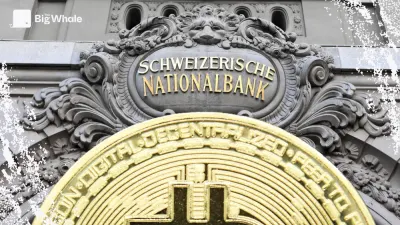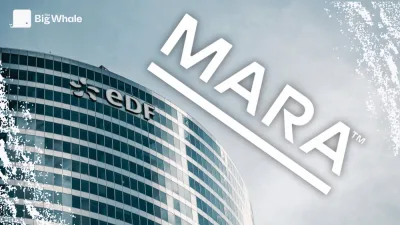TBW - Aptos (APT): Fundamental analysis of the project

What you need to know 🐳
Aptos was created by former Meta (formerly Facebook) engineers who had worked on the Libra project, originally known as Libra.
Libra, announced in 2019, aimed to create a digital asset accessible to everyone, regardless of their location or financial situation.
However, despite being renamed Libra in 2021 in a bid to dissociate the project from the many controversies and criticisms from regulators, the project was phased out in early 2022 due to strong opposition from regulators, who feared that Libra would become a threat to the supremacy of the US dollar.
Aptos was born following the abandonment of Libra, created by a group of Meta engineers and researchers, including Mo Shaikh and Avery Ching.
This project continues Libra's legacy as an independent initiative via the company Aptos Labs. Although it is based on the same underlying technology as Libra, namely a layer 1 blockchain originally designed for Libra, Aptos differs in that it is more decentralised. Unlike Libra, which was controlled by a consortium of 28 companies, Aptos is governed by a community of independent validators and by the members of its on-chain governance.
Aptos is also distinguished by its Move programming language, derived from Rust and initially developed by Meta for the Libra project. Move was created as a result of the Meta teams' desire to resolve some of the limitations and problems identified in Solidity (Ethereum's language).
Today, Aptos is one of the projects with one of the largest capitalisations in the global cryptocurrency market, with a capitalisation of $7 billion, ranking it 24th in the sector.
Overview 🧬
Launched in October 2022, Aptos is a Layer 1 blockchain using the Proof-of-Stake (PoS) mechanism.
Highly scalable design enables fast and secure transaction processing to meet the needs of mass adoption.
Thus, Aptos was able to reach a peak of 10,737 transactions per second (TPS) on its mainnet, by comparison the maximum TPS recorded on Solana is 7229.
Aptos also stands out for its extremely low transaction fees of around $0.001 per transaction.
The main aim of the project is to foster the mass adoption of decentralised applications in gaming, NFTs, DeFi and artificial intelligence.
To achieve this, Aptos is striving to create a reliable, scalable and accessible blockchain, allowing everyone to benefit from the advantages of decentralisation.
His vision is to radically improve the user experience and social interaction in the Web3 ecosystem. The project also plans to strengthen interoperability with its AptosEVM chain in 2025, facilitating the integration of Ethereum applications.
The Aptos Labs team develops tools and products to simplify the use of decentralised networks, for the benefit of developers and end users alike.
Financing 💰
Aptos has raised a total of $350 million from around 20 investors.
The project first secured $200 million in a strategic round in March 2022, followed by a $150 million Series A in July 2022. Major investors included Andreessen Horowitz (a16z), Coinbase Ventures, FTX Ventures, Binance Labs, Multicoin Capital and Tiger Global.
In September 2022, Binance Labs made an additional strategic investment in Aptos, the amount of which was not disclosed.
Team and community 👾
Aptos was founded by Mohammad Shaikh and Avery Ching, two former Meta engineers who worked on the Libra project.
- Mohammad Shaikh, CEO and co-founder of Aptos, is a seasoned entrepreneur in blockchain and financial markets. An expert in large-scale product deployment, he has a strong background in private equity and venture capital. Prior to Aptos, he led blockchain partnerships at Meta and advised the World Economic Forum on blockchain strategy.
- Avery Ching, CTO and co-founder, was a principal architect at Meta. As head of the crypto team, he oversaw the development of key components, from the wallet infrastructure to the layer 1 blockchain.
The Aptos team includes many former Meta engineers who contributed to the Libra project.
The Aptos community is strongly encouraged to participate in the development of the ecosystem. Members can chat on Discord, contribute to the Aptos Foundation forum, or discuss technical issues in the Aptos Dev Discussions on Github.
Contribution can take several forms: reporting bugs via the bug bounty programme, direct participation in code through pull-requests on GitHub, or developing personal projects.
A Code of Conduct frames these interactions to ensure a respectful and constructive environment. Members can also become ambassadors via the Aptos Collective, organising events or creating content for the ecosystem.
Aptos benefits from a large community: 627,000 subscribers on X (formerly Twitter), more than 250,000 members on Discord and more than 109,000 on Telegram.
According to Token Terminal, by the end of 2024, Aptos had more than 3.8 million weekly active users and 21 million APT token holders. Its infrastructure comprises 500 nodes, including 147 validator nodes.
Function ⛓️
Modularity and parallel transaction execution (Block-STM)
Aptos stands out for its modular and parallel architecture, optimised to improve performance and scalability while guaranteeing high security and reliability. Unlike traditional blockchains such as Bitcoin, which combine all the functions of a transaction (execution, consensus, data management, settlement) in a single layer, Aptos adopts a parallel processing approach.
Aptos' Block-STM (Software Transactional Memory) engine executes transactions in an "optimistic" manner - assuming that all transactions are correct, while allowing them to be challenged in the event of error. This system captures a snapshot of the current state of the network and allows multiple transactions to be processed in parallel, without waiting for the previous transaction to be validated.
Non-conflicting transactions are executed simultaneously, while conflicting ones are isolated and re-executed if necessary. This approach enables a potential throughput of up to 160,000 transactions per second (TPS).
In addition, Aptos has introduced Quorum Store, a feature that improves consensus throughput by eliminating the need for a centralised master node. This system enables asynchronous and parallel data dissemination, optimising transaction management during peaks in network activity. This innovation significantly enhances Aptos' processing capabilities.
In addition, Aptos' modular architecture makes it easy to integrate new nodes without compromising overall performance. Updates can be deployed independently on each module, enabling continuous improvements without disrupting the entire network.
Consensus Proof-of-Stake (PoS)
The Aptos consensus mechanism is based on Proof-of-Stake (PoS) and incorporates Byzantine Fault Tolerance (BFT) via AptosBFT. Inspired by Libra's DiemBFTv4 protocol, this system ensures network security even if some validators fail, tolerating up to 33% malicious or faulty nodes without compromising its integrity.
To participate in the consensus and validate transactions, validators must store APT tokens. The system assesses their reputation and performance, rewarding the most reliable via a rotation mechanism. This approach strengthens the efficiency of the network and consolidates the robustness of the consensus.
Move language for smart contact
The Move language, initially developed for the Libra project, is at the heart of the Aptos smart contracts system. Its key feature is its ability to be formally verified using the Move Prover tool.
This formal verification of smart contracts ensures that there are no bugs, vulnerabilities or unexpected behaviour. The process begins when an expert translates the logic of the smart contract into mathematical statements. These statements are then subjected to automated verification, which compares the actual logic with the expected behaviour of the contract. Combining this formal verification with manual auditing provides a comprehensive assessment of the smart contract's security.
This principle has already been implemented in other blockchains, such as Tezos.
State synchronisation
To ensure network consistency and performance, Aptos uses advanced state synchronisation protocols. These protocols allow nodes, whether new or lagging, to quickly update themselves with the current state of the blockchain. This approach simplifies the integration of new validators and complete nodes without requiring long synchronisation periods.
The APT token 🌕
APT is the native token of Aptos. It is used to pay transaction fees, reward validators and stakers, encourage developers to create applications on the network, and allow holders to participate in governance.
At the launch of its mainnet on 12 October 2022, Aptos issued 1 billion APT tokens with the following breakdown: community (51.02%), contributors (19%), foundation (16.5%) and investors (13.48%). There is no cap on the maximum APT supply.
APT holders can stake their tokens to secure the network and receive rewards, which are shared between validators (currently 147 active validators) and stakers. The reward rate starts at 7% per annum and decreases by 1.5% per annum to a minimum of 3.25%, over a period of 50 years. At launch, over 82% of tokens were staked. Today, with 853,236,224 tokens staked, this represents 76.18% of the total supply.
Although Aptos has implemented a mechanism for destroying part of the APT used to pay on transaction fees, the APT token remains inflationary, issuing more tokens than it burns, particularly through staking rewards that increase the total supply.
Currently, Aptos' circulating supply is 515.93 million, or 46.01% of its current total supply of 1.12 billion. The unlocking of investor vesting (which prevents investors from selling all their tokens acquired at a low price) is underway, with around half remaining to be unlocked progressively until 2026.
Aptos uses APT for its on-chain governance, allowing holders to propose and vote on AIPs (Aptos Improvement Proposals). Users wishing to participate must install a wallet (such as Petra or Aptos Connect) and store their APT tokens. When a proposal obtains sufficient support, it can be executed before the end of the voting period, guaranteeing collective and scalable management of the Aptos blockchain.
.png)
Ecosystem 🤝
The Aptos ecosystem includes more than 188 projects covering gaming, DeFi, NFTs, social networks and AI. Blockchain is also attracting giants such as Franklin Templeton, Microsoft, AWS, Google Cloud and Mastercard to develop innovative solutions.
Franklin Templeton, the US asset manager, has chosen Aptos to issue its tokenised money fund ($430m capitalisation, read our FMT comparison). Although the majority of liquidity circulates on other blockchains, notably Stellar, Franklin Templeton remains one of Aptos' major partners since its July 2022 Series A investment.
Microsoft is collaborating with Aptos to create AI solutions on blockchain, in particular the Aptos Assistant, which simplifies access to the Web3. Mastercard, meanwhile, is developing on-chain identity and verification solutions for payments and ticketing.
In entertainment, NBC Universal is using Aptos for immersive experiences, including digital ticket sales for the WonderBus Festival and film events such as Free Renfield.
In DeFi, the Aries Markets lending protocol is the project attracting the most cash (TVL), with nearly $400 million. Thala, the most popular decentralised exchange (DEX) platform, has $207 million in TVL.
The ecosystem also includes Merkle Trade, the first gamified and omnichain perpetual DEX, as well as Ondo US Dollar Yield (USDY), a stablecoin generating high returns through US Treasuries. Circle also rolled out its USDC stablecoin on Aptos in late 2024.
NFTs thrive on Aptos via the Topaz and BlueMove marketplaces, where creators and collectors trade unique digital works. The Overmind, Bruh Bears and MAVRIK collections are particularly successful here.
In social networking, the decentralised Chingari platform allows users to control their data and monetise their content via the GARI token. On the gaming side, Marblex (MBX) stands out for its immersive experiences on Aptos.
The ecosystem also includes essential services such as Petra Wallet, a non-custodial wallet, the Aptos Names Service for domain name registration (equivalent to ENS), and Cellana Finance, the first DEX on Aptos using the Ve(3,3) model in Move.
Regulation ⚖️
Start-up Aptos Labs is based in the Cayman Islands, a territory offering a flexible and favourable regulatory framework for blockchain businesses.
Thanks to the absence of corporate and income taxes, Aptos benefits from an environment conducive to its development while complying with international regulatory standards.
However, Aptos must maintain its compliance with regional regulations in order to continue providing its services globally. This adaptation requirement could become more complex with the emergence of new laws and regulations in different countries.
Competition ⚔️
Sui Network
Sui, also developed by former Meta engineers, is one of Aptos' main competitors. Like Aptos, Sui uses the Move programming language, but stands out for its unique architecture based on a Directed Acyclic Graph (DAG).
The DAG allows simultaneous and independent transactions to be executed, ensuring faster transaction finality and high throughput.
In terms of performance, Sui can theoretically process up to 297,000 transactions per second (TPS). In its initial phase, it handles around 120,000 TPS, a theoretical level comparable to Aptos.
While the two projects are often compared, Sui is more highly regarded on the technology front, while Aptos has distinguished itself by developing a wider ecosystem of partners. When it comes to adoption, the best technology is not always the one that wins.
> Read our fundamental analysis of Sui Network
Solana
Solana is one of the major blockchains in the crypto ecosystem, ranked 5ᵉ in market capitalisation with $115 billion.
Launched in March 2020 by the Solana Foundation, this layer 1 blockchain excels with its high performance and low transaction costs. It is now the benchmark for ultra-fast smart contract blockchains.
Solana reaches 4,500 transactions per second (TPS) and has totalled more than 300 billion transactions since its launch. Its importance in the blockchain ecosystem is reflected in its 86.36 million active addresses in September 2024.
Solana's maturity is demonstrated in particular by the fact that 80% of the total supply of SOL tokens is in circulation, testifying to a blockchain that is more established and stable than its recent competitors.
Thanks to its speed and low costs, Solana has attracted a large community of developers and users, particularly attracted by the memecoins that proliferate on it.
> Read our fundamental analysis of Solana
Risks and challenges 🥵
Despite its promising innovations, Aptos faces major challenges in establishing itself in a highly competitive blockchain ecosystem.
Intense competition
Aptos operates in a sector dominated by established blockchains. These projects have strong user bases, active developer ecosystems and well-established dApps. TVL's amounts bear this out:
- TVL Ethereum: $69 billion
- TVL Solana: $9 billion
- TVL Sui: $1.4 billion
- TVL Aptos: $1.2 billion
These established blockchains offer maturity and robust ecosystems. Aptos' ability to develop a dynamic ecosystem will be crucial in its quest to become the "Ethereum killer".
Move programming language: a barrier to entry?
The use of the Move language, despite its security benefits, is a potential barrier. Unlike Solidity, which is widely adopted via Ethereum and EVM projects, Move remains confined to Aptos and Sui (the latter even uses a different version, which limits connectivity between the two blockchains). This limited adoption could curb developers' interest in creating dApps on Aptos.
Governance and centralisation?
Although Aptos aims to be decentralised, the distribution of APT tokens raises questions. A significant proportion is held by contributors, investors and the Aptos Foundation, calling into question the project's effective decentralisation - a common situation for recent projects.
In fact, while 51% of tokens are intended for the community, 19% go to the lead developers and 16.5% to investors. This significant concentration in the hands of the team and affiliated entities questions the network's true level of decentralisation.
Aptos is thus labelled a "VC Chain", reflecting a governance dominated by venture capital funds rather than its community.
Economic viability
Financially, Aptos faces a crucial challenge: its expenses far exceed its revenues. According to Token Terminal, the company generated $1.5 million in revenue over the past year, compared with expenses of $528 million, creating a $527 million deficit.
This major imbalance calls into question the long-term viability of the project. To ensure its sustainability, Aptos will need to significantly increase its revenues to cover its operational and development costs.
To increase its revenues, Aptos needs to expand its user base. With just 6 million monthly active users in 2024, the blockchain remains far behind competitors such as Solana and its 86 million active addresses. This gap underlines Aptos' major challenge against established blockchains in terms of adoption.
In addition, the absence of Aptos dApps in the top 300 market capitalisations reveals the low maturity of its ecosystem and the lack of attraction among developers and users.
.png)
Technical risk
The Aptos blockchain, while ambitious in its quest for scalability, is not immune to technical problems.
On 19 October 2023, Aptos suffered a major 5-hour outage, paralysing transactions on the network. This incident revealed vulnerabilities in the management of high loads, particularly during periods of high activity, calling into question the blockchain's ability to maintain continuity of service in the event of mass adoption.
Also, Aptos could face new regulatory challenges. Diem's experience, halted under pressure from regulators, highlights the importance of legal frameworks. Aptos could face similar hurdles, especially in key markets such as the US and EU, as crypto regulations become clearer.
Roadmap 🗺️
Aptos is working on deploying lending giant Aave into its ecosystem. This proposal was accepted in July 2024 by the Aave community, which would make Aptos the first non-EVM blockchain to integrate the flagship decentralised lending application.
One of the major objectives of the Aptos roadmap is the launch of its AptosEVM chain, which will enable interoperability with Ethereum-based applications. The testnet for this chain is scheduled for the third quarter of 2025, while the deployment of the mainnet is planned for the second quarter of 2026. This initiative will expand Aptos' capabilities, with the aim of attracting more developers and users from the Ethereum ecosystem.
In parallel, Aptos is focusing on improving its governance. By 2026, the blockchain plans to implement enhanced governance mechanisms, allowing token holders to participate more actively in decision-making processes and future updates to the protocol. These improvements are intended to strengthen community involvement and ensure the sustainable development of the platform, based on the principles of decentralisation and tailored to the needs of its community.
Aptos plans to continue improving the performance of its network. The team is working on developing a new consensus protocol called Raptr based on the DAG model. In addition to this the team is also aiming to launch Block-STM v2 to extend the network's transaction processing capabilities.
The Big Whale's view 🐳
Aptos, founded by former Meta engineers, stands out for its scalability and modern architecture. Its innovations, notably the Move language and Block-STM technology, enable it to achieve high performance in terms of transactions per second.
However, despite this potential, Aptos is struggling to establish itself in terms of adoption, with a user base that is significantly smaller than that of established blockchains such as Solana. Its ecosystem, still in its infancy, will need to redouble its efforts to attract users, although the forthcoming arrival of Aave is a promising step forward.
Also of note is the significant potential of its partnership with traditional finance giant Franklin Templeton.
The high concentration of tokens in the hands of a few players raises legitimate questions about its effective decentralisation, although this situation is common for projects in the launch phase. In addition, its economic viability is a cause for concern, with expenses far outstripping revenues.
To establish itself in the ultra-competitive world of fast, low-cost blockchains, Aptos will have to overcome these major challenges.



